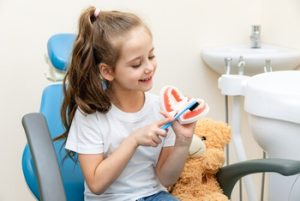Your little one’s gummy grin is one of life’s simple joys, and spotting that very first tooth is a milestone most families treasure. Yet the lead-up can be confusing. Baby first tooth symptoms often arrive in a tide of drool, crankiness, and sleepless nights, and many parents wonder which signs are “normal” and which call for professional help. This detailed, evidence-based guide walks you through everything from when most babies start teething to how to ease discomfort and protect those brand-new pearly whites.
When Do Babies Start Teething?
Although every child is different, most babies cut their first tooth somewhere between 6 months of age and 10 months. Some infants are early bloomers, sprouting their lower central incisors at four months, while others keep that gummy smile until well past their first birthday. Dentists consider anything between four and 14 months of age within the normal range.
You may notice the classic timeline unfold like this:
- Central incisors (bottom first, then top)
- Lateral incisors
- First molars
- Canines
- Second molars
By the time the primary teeth set is complete, usually around three years, your child will sport 20 baby teeth ready for chewing, speech development, and, of course, lots of adorable photos.
Spotting the Earliest Teething Symptoms
Here’s how to tell when a tooth is on its way.
Baby first tooth symptoms can be surprisingly varied, and while not every fuss or fever is tooth-related, there are consistent signs that often signal an erupting tooth. Here’s what to look for when babies start teething, especially around 6 months of age:
Common Teething Symptoms
 These are the signs most often linked to baby teething.
These are the signs most often linked to baby teething.
- Red, swollen gums:
As the first teeth begin pushing through, inflammation develops around the tooth bud, creating cushiony, bright-pink ridges in your baby’s gums.
- Sore gums and heavy drooling:
Increased saliva production helps soothe irritated tissue, but it can lead to bib-soaking dribble and a rash around the mouth and chin. This is often one of the first signs of a teething baby.
- Slight fever:
Some teething babies experience a mild temperature rise (under 38 °C). This is usually short-lived and not accompanied by other serious symptoms.
- Slight fever, pulling, and ear tugging:
Many teething symptoms show up as odd behaviours. Tugging at ears or rubbing cheeks can be your baby’s way of coping with internal gum pressure.
- Finger chewing or mouthing everything:
One of the most recognised signs is the erupting tooth-sucking fingers phase. Your baby may gnaw on fingers, toys, or anything they can get their hands on to counteract teething pain.
- Changes in sleep and appetite:
Night-time discomfort and gum pressure may cause short naps, disrupted feeds, or extra night waking. Refusing the bottle or solids can also occur.
- Other symptoms:
Some babies develop mild tummy upsets or nappy rash due to swallowed saliva. Increased fussiness is common, especially when baby teeth are close to breaking through.
When to See a dentist:
A high temperature over 38 °C, ongoing diarrhoea, or vomiting is not a typical sign of teething. These may indicate illness and should be checked by a doctor.
What’s Happening Beneath Those Tiny Ridges?
Inside your baby’s mouth, tooth buds have been forming since pregnancy. As each erupting tooth pushes through bone and soft tissue, inflammatory chemicals trigger swelling, and nerves send pain signals that feel sharp to your infant. Pressure peaks just before the tooth breaks the surface; this is when your teething baby will be the most unsettled. Once the tooth appears, the discomfort usually drops off quickly.
Safe and Unsafe Comfort Measures
Teething can turn calm households upside-down, so let’s separate tried-and-true comfort hacks from strategies that pose a potential choking hazard.
The Gold-Standard Soothers
- Clean finger: Wash hands thoroughly and apply gentle rubbing pressure along the gum line. You can also gently rub a drop of expressed breast milk for extra familiarity.
- Wet washcloth: Twist a chilled (not frozen) cloth into a firm rope. The texture and coolness ease teething pain without damage.
- Cold spoon: Chill a metal teaspoon in the fridge, not the freezer, and press the back against sore gums.
- Teething rings: Look for one-piece silicone models meeting Australian safety standards. Refrigerate (again, never freeze) for extra relief.
- Teething gels: Sugar-free, alcohol-free gels provide mild topical pain relief. Use sparingly and follow age guidelines on the packaging, or speak with your dentist if unsure.
- Teething tablets & homoeopathic remedies: Research is mixed, but some parents report success. Choose TGA-listed brands, follow dosing exactly, and monitor for allergies.
- Teething necklaces & amber teething necklaces: Jewellery around an infant’s neck is a choking hazard. The Australian Competition & Consumer Commission (ACCC) warns against them; if you opt in, wrap the strand around the ankle under a sock during naps, and supervise continuously.
Unsafe Teething Remedies to Avoid
Many parents try a range of remedies to ease discomfort during baby teething, but some common methods can pose serious risks, especially when they create a choking hazard or irritate your child’s gums. Here are a few options to avoid entirely:
Teething Practices That Can Do More Harm Than Good
- Frozen foods or bread crusts:
While they might seem soothing, hard frozen textures can bruise a baby’s gums or break off into chunks, posing a potential choking hazard. Even when a tooth appears, hard foods remain risky.
- Liquid-filled plastic teething rings:
These can leak fluid or become mouldy over time. Opt for one-piece silicone teething rings instead to support your teething baby safely.
- Teething gels with benzocaine:
Benzocaine has been linked to rare but serious reactions. Safer alternatives include teething gels without anaesthetic, or homoeopathic remedies approved for infant use, with careful monitoring for allergies.
- Rubbing spirits or honey on gums:
Alcohol-based remedies can irritate delicate baby’s gums, and honey should never be given to babies under 12 months of age due to the risk of botulism.
Note: Items like teething necklaces and amber teething necklaces are also discouraged by safety bodies, including the ACCC, due to their strangulation and choking hazard risks. If used, they should never be worn unsupervised and should never be worn around the neck during sleep.
Caring for Your Baby’s First Teeth
Oral hygiene starts before teeth emerge. Here’s a stage-by-stage roadmap aligned with Australian Dental Association guidance.
Pre-Eruption (0–6 months)
- Wipe baby’s gums twice daily with a soft, damp pad to remove milk residue and help them get used to having their mouth cleaned.
 First Tooth to Two Teeth
First Tooth to Two Teeth
- Once that debut baby tooth erupts, switch to a silicone fingerbrush or soft-bristled toothbrush.
- Use a small pea-sized amount of low-strength fluoride toothpaste (about 500 ppm). Brush twice a day, morning and night.
- Introduce water in a cup at mealtimes to rinse sugars away.
A Few Teeth to Full Set
- From 18 months, graduate to standard-strength fluoride toothpaste (1,000 ppm), still in a pea-sized amount.
- Add gentle dental floss between the front teeth once the contacts close.
- Schedule a dental visit by your baby’s first birthday or within six months of eruption, whichever comes first, for assessment, diet advice, and fluoride varnish if risk factors exist.
Consistent cleaning sets the stage for healthy teeth, lowers tooth decay risk, and builds lifelong habits.
Spotlight on Tooth Decay in Infancy
Early-Childhood caries can begin as soon as teeth appear. Bacteria love lingering sugars from night-time feeds or juice bottles, converting them into acids that demineralise enamel. If unchecked, lesions progress fast because baby enamel is thinner than that of permanent teeth.
Watch for:
- White-chalky spots along the gum line
- Dark blotches or pits
- Sensitivity when teeth break through
Regular dental check-ups during early childhood allow for timely intervention, often just remineralising paste and dietary tweaks instead of fillings.
FAQs Parents Ask Every Day
Quick answers to common teething concerns from parents.
“Is it normal for teething babies to refuse food?”
Yes. Gum pressure alters appetite. Offer chilled purées, yoghurt, or a silicone feeder filled with cold fruit. Hydration is key.
“My child has been drooling for weeks, but no tooth. Should I worry?”
Not necessarily. Salivary glands mature around three months, so drool can precede teething by months. Look for gum changes or other teething symptoms.
“What about teething gels with lidocaine?”
Lidocaine-based formulas are prescription-only in Australia due to overdose risk. Stick to pharmacy-recommended lignocaine-free gels, and never exceed directions.
When to Call the Dentist 
- Fever above 38 °C lasting more than 24 hours
- Refusal of all feeds or liquids
- Rash spreading beyond the mouth
- No teeth emerge by 18 months
- Swelling so severe the tongue or airway is compromised
Prompt advice ensures the child’s teeth develop on schedule and keeps broader health on track.
Looking Ahead to Permanent Teeth
Caring for primary teeth isn’t just about comfort now; they guide permanent teeth into correct alignment later. Premature loss from decay can lead to crowding, speech issues, and costly orthodontic care. Setting sound habits around brushing, diet, and regular dental visits right from the first tooth appearance pays dividends well into adulthood.
Key Takeaways for Time-Poor Parents
- Teething typically begins around 6 months of age, starting with the lower central incisors.
- Classic signs include drool, red swollen gums, sore gums, and a mild fever.
- Safe comforts: chilled teething rings, a cold spoon, a wet washcloth, and a clean finger for massage.
- Avoid items posing a choking hazard, including some teething necklaces and frozen foods.
- Brush with fluoride toothpaste as soon as the first baby tooth shows, using a soft-bristled toothbrush and a pea-sized amount twice daily.
- Visit the dentist by age one for guidance, potential fluoride varnish, and to track eruption.
- Vigilance now prevents tooth decay and paves the way for healthy teeth for life.
Final Word
Teething is a rite of passage marked by smiles and sometimes tears. Understanding the process, recognising early cues, and responding with safe, soothing strategies allow you to support your little one through each erupting tooth. Combine comfort measures with diligent oral care, and you will set your child on the path to robust, sparkling teeth from the very first milestone all the way to their adult grin.
If you’re concerned about persistent teething symptoms or want expert guidance on caring for your baby’s first teeth, book a consultation with us at Advanced Dental Care Dubbo and call us at (02) 6188 7103. We’re here to support you and your little one at every step of their smile journey.
Resources
Mitchell, K., Durning, M. V. & WebMD Editorial Contributor. (2024). ‘Teething – What You Should Know’. New York, NY: WebMD, 10 May.
https://www.webmd.com/parenting/baby/teething-symptoms-remedies
KidsHealth NZ. (2022). ‘Caring For Your Baby’s Teeth’. Auckland, NZ: KidsHealth, 29 April.
https://www.kidshealth.org.nz/caring-for-your-babys-teeth
Colgate Professional. (n.d.). ‘Caries’. Surrey, UK: Colgate-Palmolive.
https://www.colgateprofessional.co.uk/caries







